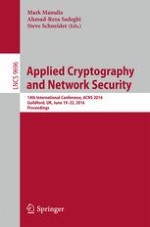2016 | OriginalPaper | Chapter
Low-Cost Mitigation Against Cold Boot Attacks for an Authentication Token
Authors : Ian Goldberg, Graeme Jenkinson, Frank Stajano
Published in: Applied Cryptography and Network Security
Publisher: Springer International Publishing
Activate our intelligent search to find suitable subject content or patents.
Select sections of text to find matching patents with Artificial Intelligence. powered by
Select sections of text to find additional relevant content using AI-assisted search. powered by
